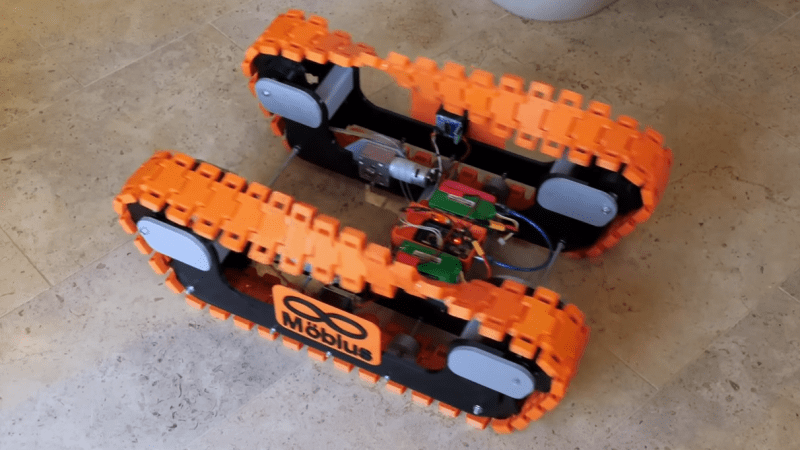It started with someone asking [James Bruton] about using a Möbius strip as a tank tread. He wasn’t sure what the point would be, but he was willing to make one and see what happened. Turns out it works reasonably well!

The main design challenge was creating a tread system that would allow for the required rotation. [James] designed in the ability for each link to rotate about 18 degrees, and ensured plenty of open space on the upper side of the drive train to accommodate a full 180 degree twist. It took a little fine-tuning and looks a bit trippy, but in the end works about as well as a regular tread system.
[James] shows off a good technique to keep in mind when constructing big assemblies like this tank. It takes a lot of time and material to print large pieces, and in such cases it’s especially important to minimize rework. [James] therefore designs smaller, separate pieces as interfaces to other parts. This way, if changes are needed down the line (for example, to adjust motor placement or change tension on parts), only a smaller interface piece needs to be redone instead of having to re-print a huge part.
The unit uses an Arduino Mega, two 24 V gearmotors to drive each tread independently, an RC radio receiver, and some beefy BTS7960 DC motor drivers to drive the motors.
[James]’ unit is pretty big, but we’ve also seen 3D printed tanks capable of carrying a human driver. It’s clear that build plate size doesn’t seem to limit tank designs. Watch the Möbius tank get built and drive around in the video, just below the page break.
















I suppose an advantage is that you wear “both sides” of the track, so it might be better for longevity. One disadvantage is that on the other hand, you are constrained into designing a track that is reversible which is probably not functionally optimum.
Seems impractical from wear leveling view. Treads typically have x thickness of material before it has to be replaced from wear. With the twisted treadmill, both sides would need some material, and if the tread was designed with half of the material on each side to keep overall tread thickness the same, they would wear down in about same amount of time. But flexing from the twist seem like it’d wear down faster in the end.
I’ve seen this design on drive belts in reconstructed US Colonial Era water mills. It presumably evens the wear since “both sides” of the leather belt can wear against the shaft it turns. I’m not sure how this worked in practice since wearing from the inside (=contact side) out should be the same as wearing from both sides to the middle.
If you lengthen each side, there’ll be more room for the twist to complete and maybe run smoother. Nice idea!
Would the links shed mud and debris better than a conventional tread?
Well considering that the treads would bring more dirt into contacts with the sprockets it might actually make performance worse.
The best part is when he put some rubber pads on one side of the moebius track…
Btw at the begining of the video he cuts the moebius paper in the middle, but he may get definitely best result by cutting it at 1/3 !
“The best part is when he put some rubber pads on one side of the moebius track…”
LOL!
this was a great opportunity to call it Robius.
👆 This
YouTube views
I still don’t see the point of it. I can’t think of a single advantage it has, and it has the disadvantages of increased complexity, increased wear because of the twisting, forcing more mud and debris between the tread and the rollers, and greater difficulty to replace in the field on an actual tank. Not everything that can be done should be done, and this one was clearly done only for the clicks. I realize it is easy to simply ignore articles like this, but sometimes I wish HaD had better standards.
Why does something have to have a specific use to be worthwhile? Or be an improvement over alternatives? Rube Goldberg devices are one example of a device that is by its very nature less effective than any other device at doing what it does. It’s just there for the fun and beauty of it.
Really, I wish you had better standards.
From Wikipedia :
“Although the Möbius strip may appear only as a mathematical curiosity or an artistic construct, this arrangement was often used in the industrial world of the 19th century when machines ran on belts. The belts were crossed at the junction in order to wear “both sides” of the belt at the same time. In fact, the description of the Möbius strip will make it appear that the belt had only one side.”
Now in case the moebius track can be used as some kind of battle tank tracks, I would suggest the experimenter to use a Klein bottle as the cannon…
Just don’t put the twist the treads and have a great open source tank platform?
Why does there need to be a “point?” That’s like saying the only possible valid reason for education is increased income, otherwise “what’s the point?”
There is no point to anything since we’re all going to die. Happy holidays!